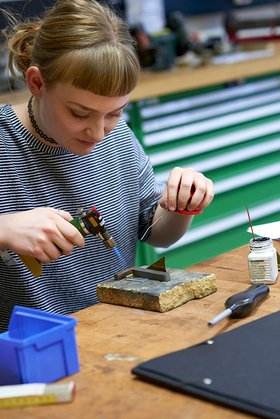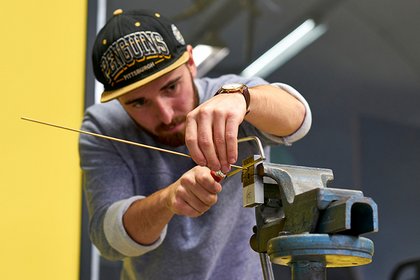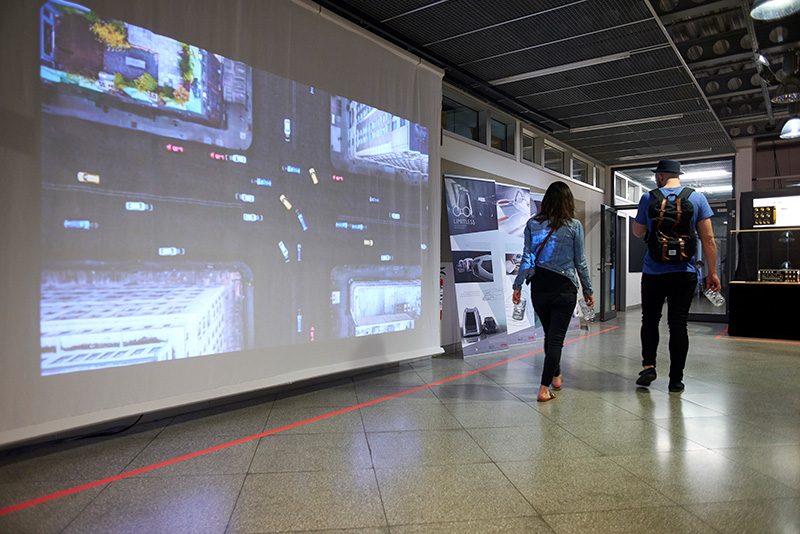
Integrated Product Design
In A Nutshell
Profile

Integration means "connecting". The academic program connects design-related subjects with many other disciplines. This variety comprises economy, technology, ecology, and social issues. From church pew to high-tech bicycle, from running shoe to musical instrument – the work of our students varies widely. Everyone integrates their own personal interests. We support talents individually. In addition, there are educational standards at Coburg that all students must complete. They are based on the requirements of the labor market so that students can be prepared optimally for the working world. The mandatory principles in education ensure the high level of Coburg’s graduates. In the meantime, word has spread about these standards in many design firms and creative departments of businesses. The design program in Coburg has tradition. We have been providing practice-based education for future creative newcomers to the field since the 1998/99 winter semester.
Without "training wheels" from the beginning
In Coburg you learn design without "training wheels". This means: From the beginning, you train under realistic conditions – instead of just pondering the theoretical aspects of products in an academic ivory tower. Starting in the third semester, for instance, our students design real products in collaboration with businesses. They may be medical devices, guest bathrooms, multimedia products, or coffee machines. We maintain collaborations with a series of different companies and research institutions. Students are under close supervision during these projects. They receive weekly feedback and learn more than just design. They also learn about research, team work, and how to organize one’s time. They definitely have projects where they have to work under deadline pressure – as they will have to in the real world. We do not believe in just letting creative persons tinker around freely during the program – without framework conditions. This only leads to many talents being under-challenged, resulting in problems with establishing themselves in the real professional world later on. And experience has shown: Only those who know what the limits are – economic and technical – can overcome them and take it to the next level in the form of paradigm-shifting products and services.
Practical Training
Workshop internship
Intellectual flights of fancy in design must always be measured by reality. For this reason, the first and second semester integrate 18 credit hours of basic education in our workshops. This is where they familiarize themselves with technologies, such as lathes, mills, and drills. They learn the "craft" – they use their hands to create sculptures, shapes, and objects from various materials. In the shops, they learn all facets of model building and how to use computer-aided machines.
Required internship semester
The required internship takes place during the entire 5th semester spanning 18 weeks, which students spend in a design firm – anywhere around the world. There they are able to implement many of the things they have learned in the program. It is accompanied by a practical seminar.
Structure of the Program

Product design is a diverse discipline. For this reason, the academic program offers interdisciplinary courses. We value solid technical training. The program includes subjects such as materials, construction principles, mechanics, lightweight construction, ergonomics, technical drawing, and new production technologies, such as digitalized production. The program has its own material lab in which our students can familiarize themselves with various materials. Business administration is also covered by our curriculum. Our students learn how to think in terms of business in numerous projects with businesses. Here, they develop products under "real" conditions. Some of our students’ designs have even made it onto the shelves of retailers.
The integrated product design program at Coburg University specifically covers:
- Fundamentals of design
- Representation methods, computer-aided representation
- Design and construction
- History of design
- Technical mechanics, materials
- Foundations of business administration, marketing
- Psychology of perception
Curriculum and Examination Regulations
For more information about the contentsof the program see here*. The [study and examination regulations]* form the legal basis for the study program. Contact your academic advisor Prof. Wolfgang Schabbach concerning the content of the program.
*only available in german at the moment
Einmal im Jahr organisieren die Studierenden auf dem Campus Design die Werkschau "Campus.Design Open". Sie zeigen ihre Werke aus den vergangenen Semestern. Außerdem gibt es öffentliche Lehrveranstaltungen, Workshops, Vorträge, Führungen durch die Gebäude, Musik und noch so manches mehr ...
External content
Job Perspectives

We are primarily interested in giving future creative newcomers to the field a realistic idea of their future work. This also includes for instance the fact that designers increasingly work as consultants for businesses. "How can we reach older people with our products?", "How can design improve the image of our company?" – Businesses are asking designers these types of questions more frequently. To answer them, designers need to be creative strategists with manager qualities; they need to be intellectually able to think beyond mere design.
With their highly qualified work, designers contribute significantly to the success of businesses. We teach students that design has a high cultural and economic value – and thus comes at a price. This is also part of the practical world: Training a confident future generation that knows how important their work is and does not sell their ideas below value.
Master's degree
After completing the Bachelor’s degree, good graduates have the possibility of obtaining further qualifications with a Master's degree. For this purpose, the Coburg University offers the Masters' Program "Design M.A.".
Application and Admission Requirements
Here you can find all the important information about evaluating your school-leaving certificates and learning German in order to start a bachelor program at the University of Coburg.
Since the program is taught in German, you also have to prove your knowledge in German before the start of studies (level C1/C2).
Aptitude test
The aptitude test takes place in July. After the application deadline, all applicants will receive a written invitation to the aptitude test with a detailed schedule.
They will get to show off their artistic, design, and construction skills in the 2-day aptitude test. It strives to mobilize their creative powers and test them indirectly through these practical exercises. In order to get an idea of their creativity ahead of time, they are asked to complete a homework assignment for the end of June/ start of July within approx. 10 days and to submit it ahead of time for evaluation.
Parts of these exercises test shape and spatial imagination, expressiveness in design, analysis of function and effect, the connection of handling and design, and the connection of function, material, and shape. The tests require the student partly to draw and partly to demonstrate their practical work, handicraft, and design. A brief personal interview rounds off the aptitude test.
